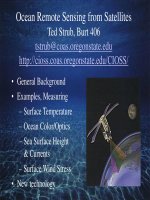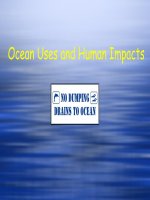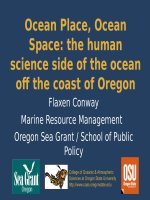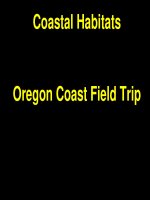Geography and Oceanography - Chapter 19 docx
Bạn đang xem bản rút gọn của tài liệu. Xem và tải ngay bản đầy đủ của tài liệu tại đây (10.28 MB, 34 trang )
Using Gliders to Monitor Oregon’s
Using Gliders to Monitor Oregon’s
Coastal Ocean
Coastal Ocean
OSU Glider Group: Kipp Shearman, Jack Barth, Anatoli Erofeev, Tristan Peery,
OSU Glider Group: Kipp Shearman, Jack Barth, Anatoli Erofeev, Tristan Peery,
Justin Brodersen and Laura Rubiano-Gomez
Justin Brodersen and Laura Rubiano-Gomez
•
Autonomous Underwater
Autonomous Underwater
Gliders
Gliders
•
Describe the OSU glider
Describe the OSU glider
operations
operations
•
What are we learning?
What are we learning?
•
The Future of Ocean Observing
The Future of Ocean Observing
Kipp Shearman
Kipp Shearman
College of Oceanic & Atmospheric Sciences
College of Oceanic & Atmospheric Sciences
Oregon State University
Oregon State University
What’s a glider?
What’s a glider?
•
Autonomous underwater vehicle – a robot!
Autonomous underwater vehicle – a robot!
•
Flies by changing its buoyancy
Flies by changing its buoyancy
–
takes on water, becomes heavy and sinks
–
wings turn vertical motion into forward motion
–
expels water, becomes light and rises
–
flies saw tooth pattern through the ocean
–
from the surface to 3 m off bottom (200 m max)
•
Slow, but can stay out a long time
Slow, but can stay out a long time
–
½ - 1 knot
–
3-4 week endurance
•
GPS for positioning
GPS for positioning
•
Communicates to home by Iridium satellite phone
Communicates to home by Iridium satellite phone
•
Collects same data you would on a research vessel at a fraction of
Collects same data you would on a research vessel at a fraction of
the cost
the cost
–
Research vessel: approx. $20K/day
–
Glider: $100K to buy + $200/day (batteries + communications + techs)
–
400 days of glider operation:
400 days x $20K/day – ($100K+400 days x $200/day) = $7.8 million saved!
400 days x $20K/day – ($100K+400 days x $200/day) = $7.8 million saved!
CTD
CTD
Optical Sensors
Optical Sensors
(Chl, CDOM and
(Chl, CDOM and
Backscatter)
Backscatter)
Pitch Batteries
Pitch Batteries
Science Bay
Science Bay
Displacement Pump
Displacement Pump
Glider Control and
Glider Control and
more batteries
more batteries
Air bladder
Air bladder
Aanderaa Optical
Aanderaa Optical
Dissolved Oxygen
Dissolved Oxygen
sensor
sensor
GPS, Iridium and
GPS, Iridium and
Freewave Antennae
Freewave Antennae
in tail fin
in tail fin
Webb Slocum Electric Glider
Webb Slocum Electric Glider
7 ft long
7 ft long
100 lbs in air
100 lbs in air
Glider Bob
Glider Bob
February
February
2005
2005
Bob Smith
Bob Smith
Jane Huyer
Jane Huyer
Glider Jane
Glider Jane
June 2005
June 2005
The OSU Glider Fleet
The OSU Glider Fleet
Two Webb gliders
Two Webb gliders
200 m depth
200 m depth
3 week deployment
3 week deployment
SeaGlider (Aug 2007)
SeaGlider (Aug 2007)
1000 m depth
1000 m depth
6 month deployment
6 month deployment
Two new SeaGliders
Two new SeaGliders
(Jul 2008)
(Jul 2008)
Newport Line
Newport Line
•
90 km cross-shelf
90 km cross-shelf
•
Strong currents (50+ cm/s)
Strong currents (50+ cm/s)
•
Complex Bathymetry
Complex Bathymetry
•
Historical Observations
Historical Observations
(1950s)
(1950s)
Umpqua River Line
Umpqua River Line
•
Summer 2007
Summer 2007
Apr 2006 – May 2010
Apr 2006 – May 2010
•
1275 glider-days
1275 glider-days
•
32,388 km
32,388 km
•
481 cross-shelf
481 cross-shelf
sections
sections
•
125,283 vertical profiles
125,283 vertical profiles
OSU Glider Operations
OSU Glider Operations
Glider Sections
Glider Sections
2-5 days per section
2-5 days per section
100 – 500 m along track resolution
100 – 500 m along track resolution
0 to ~3 mab (200 m max)
0 to ~3 mab (200 m max)
Surface every 6 hrs to get GPS fix,
Surface every 6 hrs to get GPS fix,
download data and receive new
download data and receive new
instructions (via Iridium)
instructions (via Iridium)
21 day endurance
21 day endurance
Also measures CDOM fluorescence
Also measures CDOM fluorescence
and average currents
and average currents
Salinity
T (°C)
Chlorophyll
(μg/L)
Backscatter
(1/m)
Dissolved
Oxygen (mL/L)
May 05 – 10, 2006
May 05 – 10, 2006
Real-Time Glider Data
Students and Gliders
Students and Gliders
Rice
The Oregonian
Sept 20, 2006
Oregon Field Guide, Episode 1707
Oregon Field Guide, Episode 1707
Our 15 minutes of fame.
Our 15 minutes of fame.
Jane and Bob together
for CROOS collaboration
Bob springs a leak
First mission; We fly till
Bob runs out of batteries
Bob leaks again
Bob flies through 35+ ft
seas!
Jane off New Jersey
Jane drops emergency
weight
Bob disappears for 8
days!!
Jane Starts Umpqua
River Line, springs leak
Winter – get data when
weather allows
Jane surf rescue!
2008 Season: 2-4 gliders
Bob meets UO fans
Winter starts early
March 2007
March 2007
Surf Rescue
Surf Rescue
Dan and Ollie save Jane from certain doom
Dan and Ollie save Jane from certain doom
Seaglider rescued by Chilean Navy
Seaglider rescued by Chilean Navy
– July 2009
– July 2009
What are we learning?
What are we learning?
•
The Structure of Upwelling
The Structure of Upwelling
•
Hypoxia on the Oregon shelf
Hypoxia on the Oregon shelf
Winds, Ekman Transport and Coastal Upwelling
Winds, Ekman Transport and Coastal Upwelling
Northerly winds
Northerly winds
Offshore Ekman transport
Offshore Ekman transport
Upwelling brings deep water to
Upwelling brings deep water to
the surface near the coast
the surface near the coast
Deep water cold, nutrient rich
Deep water cold, nutrient rich
and oxygen poor
and oxygen poor
The Oregonian
July 25, 1996
blue = cold
blue = cold
red = warm
red = warm
Summer vs. Winter along the US west coast
Summer vs. Winter along the US west coast
courtesy of
Andy Thomas (U Maine)
mg/m³
upwelled nutrients
feed phytoplankton
Seasonal variations in copepod biomass
at NH 5 (depth = 60 m)
Month of the Year
Jan Feb Mar Apr May Jun Jul Aug Sep Oct Nov Dec
Copepod Biomass (mg C m
-3
)
0
20
40
60
80
100
1996-1998
1999-2002
May-September Averages + 95% confidence interval
1996 9.2 + 2.54 mg carbon m
-3
1997 9.7 + 1.35 "
1998 10.1 + 1.51 "
1999 11.0 + 2.31 "
2000 25.5 + 6.81 "
2001 21.5 + 4.02 "
2002 16.2 + 4.84 "
courtesy of Bill Peterson (NOAA/NMFS/OSU)
Phytoplankton feed copepods
Very cold water; 8
Very cold water; 8
°C
°C
Glider Observations of Upwelling
Glider Observations of Upwelling
Columbia River Plume
Columbia River Plume
Jane drops emergency
weight
Glider Observations of Upwelling
Glider Observations of Upwelling
April 5-8









